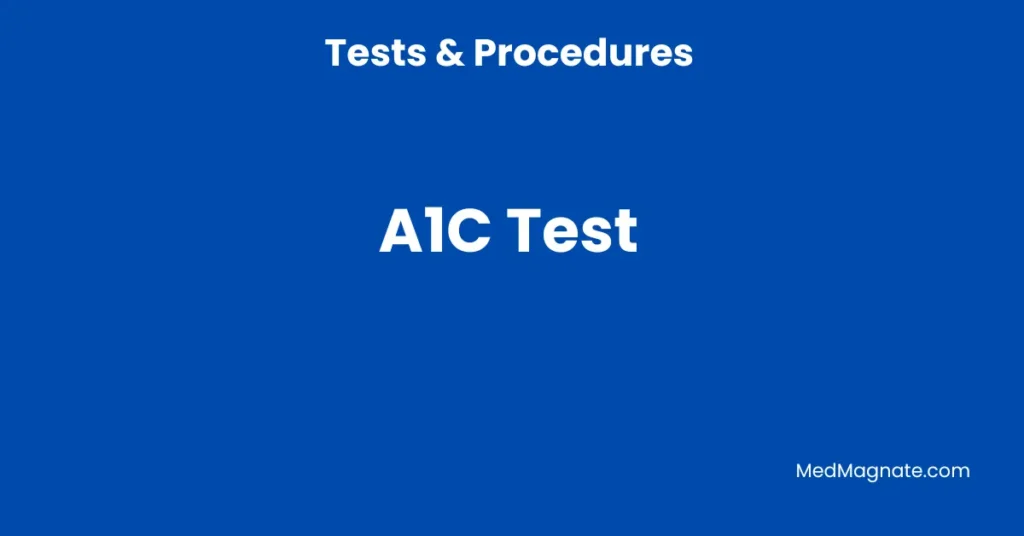The A1C test is a blood test that helps measure average blood sugar levels over the past 2–3 months. It is commonly used to diagnose and monitor diabetes.
Unlike regular blood sugar tests that measure sugar at a single point in time, the A1C test gives a bigger picture of how well blood sugar is controlled over a longer period.
What is the A1C Test?
The A1C test, also called HbA1C or glycated hemoglobin test, measures the percentage of hemoglobin in the blood that is coated with sugar (glucose).
- Hemoglobin is a protein in red blood cells that carries oxygen.
- When blood sugar is high, more sugar attaches to hemoglobin, increasing the A1C value.
The test helps doctors understand long-term blood sugar control, which is crucial in diabetes management.
Normal A1C Range
A1C results are reported in percentages (%).
| A1C Value | Meaning |
| Below 5.7% | Normal – low risk of diabetes |
| 5.7% – 6.4% | Prediabetes – higher risk of developing diabetes |
| 6.5% or above | Diabetes – requires further evaluation or treatment |
Target for people with diabetes:
- Usually below 7%, but it may vary depending on age, health condition, and doctor’s advice.
Why is the A1C Test Important?
- Diagnoses Diabetes and Prediabetes: Helps identify people at risk.
- Monitors Blood Sugar Control: Shows if current diabetes treatment is working.
- Reduces Complications: Helps prevent heart disease, kidney problems, and nerve damage by keeping blood sugar under control.
- Long-Term Overview: Provides a better picture than daily blood sugar readings alone.
How the A1C Test is Done
- A small blood sample is taken from a vein in your arm.
- The test does not require fasting, so you can eat or drink normally before it.
- Results usually take a few hours to a day depending on the lab.
Factors Affecting A1C Results
Certain conditions may affect A1C accuracy:
- Anemia or low red blood cell count
- Kidney or liver disease
- Recent blood loss or transfusions
- Pregnancy
Your doctor may consider these factors while interpreting results.
How Often Should You Get an A1C Test?
- People without diabetes: Every 3 years after age 45.
- People with diabetes: Usually every 3–6 months, depending on how well blood sugar is controlled.
Tips to Maintain Healthy A1C Levels
- Follow a healthy diet – Include vegetables, whole grains, lean proteins, and limit sugary foods.
- Exercise regularly – 30 minutes a day helps control blood sugar.
- Take medicines as prescribed – Insulin or oral diabetes medicines should be taken on time.
- Monitor blood sugar – Track daily readings to see how lifestyle changes affect A1C.
- Avoid smoking and limit alcohol – Both can affect blood sugar control.
Conclusion
The A1C test is a simple blood test that measures average blood sugar levels over 2–3 months. It helps in diagnosing diabetes, monitoring treatment, and preventing complications.
Regular testing, along with healthy lifestyle changes, is key to maintaining good blood sugar control.
FAQs
Q 1. What is a normal A1C level?
Below 5.7% is considered normal. 5.7%–6.4% indicates prediabetes, and 6.5% or above indicates diabetes.
Q 2. Does the A1C test require fasting?
No, you can eat and drink normally before the test.
Q 3. How often should I check my A1C?
- People without diabetes: every 3 years after age 45
- People with diabetes: every 3–6 months
Q 4. Can A1C be wrong?
Yes, conditions like anemia, liver or kidney disease, or recent blood transfusions can affect results.
Q 5. How is A1C different from daily blood sugar tests?
Daily tests show sugar levels at that moment, while A1C reflects average levels over 2–3 months.
Q 6. How can I lower my A1C naturally?
Eat healthy, exercise regularly, take medicines as prescribed, and avoid smoking or excessive alcohol.
Q 7. Can stress affect A1C?
Stress may temporarily raise blood sugar but usually does not significantly change A1C over time.

